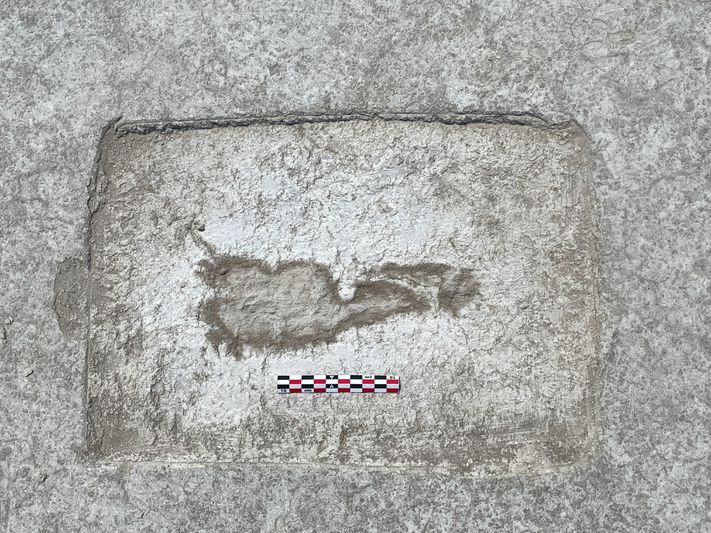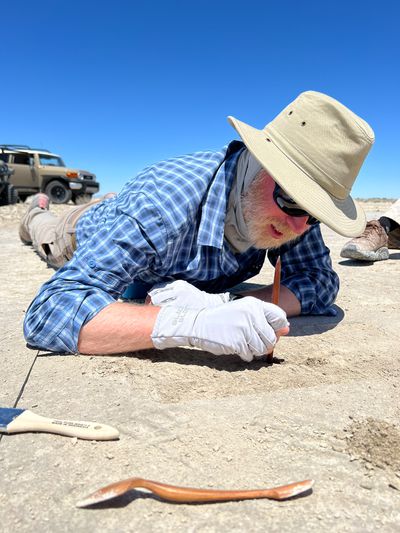‘Like a Polaroid developed:’ Ancient footprints found in Utah offer window into human life 12,000 years ago
Anastasia Hufham
On a hot Thursday in July, two archaeologists bumped along a dusty road in the middle of the Great Salt Lake Desert.
One was Daron Duke, an archaeologist with the Far Western Anthropological Research Group. The other was Tommy Urban, a researcher at Cornell University. Last year, Urban was part of a team that discovered ancient footprints in White Sands National Park that date back to 23,000 years ago — 10,000 years before scientists previously thought humans arrived in the Americas.
Gazing out onto the arid landscape, Urban remarked how similar the Great Salt Lake Desert looked to the New Mexico national park. The two chatted about the footprint discovery, and Duke asked Urban what the tracks had looked like before excavation.
“He just looked out the window and said, ‘They look kind of like that,’” Duke said.
They had, in fact, stumbled upon 88 ancient human footprints belonging to both adults and children. The tracks could be up to 12,000 years old.
At first, Duke was skeptical that they had actually found footprints. He spent three days with his nose to the ground, vetting them. Finding out they were actually boot prints from the last decade would have been rather anticlimactic, after all.
He scored squares around a few of the less-distinctive tracks with his pocket knife to identify them. Then, he scraped them clean, trying to discern if the space left behind actually resembled a human footprint.
It looked like nothing.
Duke went back to his truck to eat an apple and regroup. When he returned, something had changed.
“It was like a Polaroid developed,” he said. “The sand stays the same color and the mud surrounding it turns white. I just had to wait.”
The footprints were so clear that he could see toes and a heel on one of them. “That’s when I became excited,” Duke said. It marked only the second such discovery in the United States.
The discovery
The discovery was technically on what is now the Utah Test and Training Range, managed by the U.S. Air Force. Hill Air Force Base consults with 21 Native American tribes about archaeological sites in the area.
Last month, four local tribal representatives toured the Trackway Site, coming face to face with footprints belonging to their ancestors.
“These are remnants and remains of living, breathing culture,” said Anya Kitterman, cultural resource manager for the Air Force base. “We walked with the tribe, side by side, where their ancestors walked. That connection felt real — the connection of the ancient ancestors to their modern counterparts.”
The footprints formed back when the Great Salt Lake Desert was covered in water — one of the largest wetlands in the Great Basin. Such wetland conditions haven’t existed in Utah for about 10,000 years.
Duke said the region would have been like an ancient New York City, a central hub of life. After these people stepped ankle-deep in mud 12,000 years ago, water and sand immediately filled in their prints, preserving their shape.
When water drained from the area, the people living there also left. But millennia of rain and erosion have made their footprints visible again.
The Trackway Site sits less than a half-mile from another prehistoric archaeological find in the area: an ancient hearth, stone tools and burned tobacco seeds discovered in 2015 — revealing the earliest evidence of human tobacco use.
Duke, who wrote his doctoral dissertation about the area where the footprints were discovered, said they were likely formed in the same period as the items found at the other site nearby: the Pleistocene age. The recent discovery unfolded as Duke and other archaeologists worked on a 5,000-acre archaeological survey at the Utah Test and Training Range.
The tracks discovered in New Mexico and now Utah have commonly been called “ghost footprints,” a term referring to how the footprints disappear and reappear with time. However, Indigenous peoples have expressed that the term is inaccurate and disrespectful.
“These [footprints] are still connected to living cultures,” Kitterman said. “And to be able to be out there with some of the tribal members...these are their forefathers.”
‘Something that should be shared’
Amid the excitement about this discovery, there is still work to be done.
First, Duke wants to date the footprints directly. If archaeologists can find organic compounds within the sand that filled in the footprints, they can date them more accurately.
Beyond the starkly scientific, the archaeologists are interested in the human connection. Duke hopes to learn more about what these children and adults — possibly whole families — were doing in the ancient wetland.
They weren’t wearing shoes, Duke explained, suggesting that they lived close by. The tracks are also short, so it doesn’t seem like they were trekking across the mud during a long journey. And the footprints are concentrated in some areas, as if people were standing together or milling around a stream.
These details, coupled with the discoveries at the other site nearby, can provide more insight into who these people were. The Air Force and the archaeologists hope to share these findings with tribes and the public.
“Erosion has revealed them, and now erosion stands to destroy them,” Duke said. “So there’s some pressure to do research on them to get what we can before they disappear.”
Some options include digging out the tracks, 3D models, taking casts or applying other methods of erosion protection.
Another question is that of management, though such discussions are still in early stages. The Air Force has been working closely with White Sands National Park to determine best practices — “not only just for how we manage it, and how we work with the tribes or not,” Kitterman said, “but also, how do we bring this really unique resource out to the public? Because it is something that should be shared.”
Michelle Cottle, the environmental chief and installation tribal liaison officer for the Air Force base, said officials are working with local tribal partners to set up meetings about what’s next for the Trackway Site.
Some tribes have expressed interest in the site, including the Confederated Tribes of the Goshute, whose reservation lies entirely within the Hill Air Force Base boundary, as well as the Northwestern Band of the Shoshone, the Eastern Shoshone, the Duckwater Shoshone Tribe and the Paiute Indian Tribe of Utah.
A representative for the Northwestern Band of the Shoshone did not respond as of Friday afternoon to The Salt Lake Tribune’s request for comment.
The Air Force plans to include tribal representatives in their annual monitoring of significant sites on the base, where they check for human and natural impacts, Kitterman said.
“It’s amazing to have this view of the past,” Duke said. “And it begs the question, what else can we find?”



en
2022-08-13T12:00:03.2820000Z
2022-08-13T12:00:03.2820000Z
https://www.sltrib.com/news/2022/08/13/like-polaroid-developed-ancient/